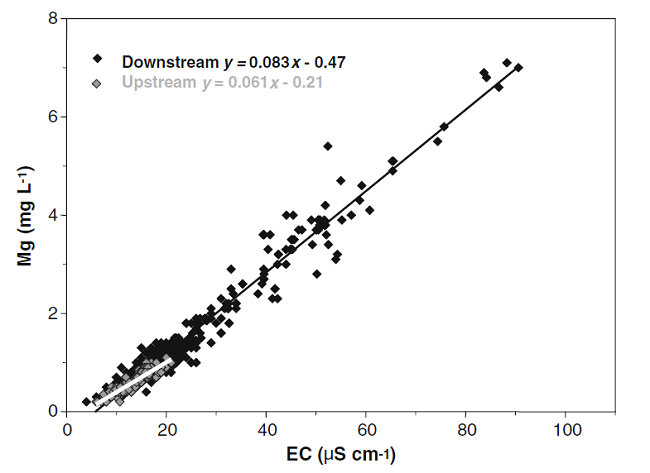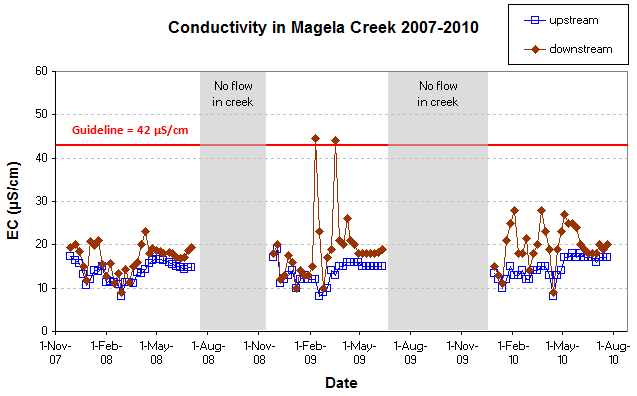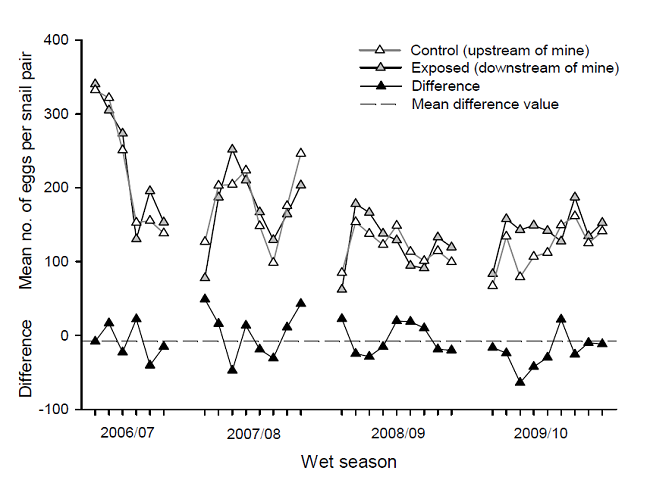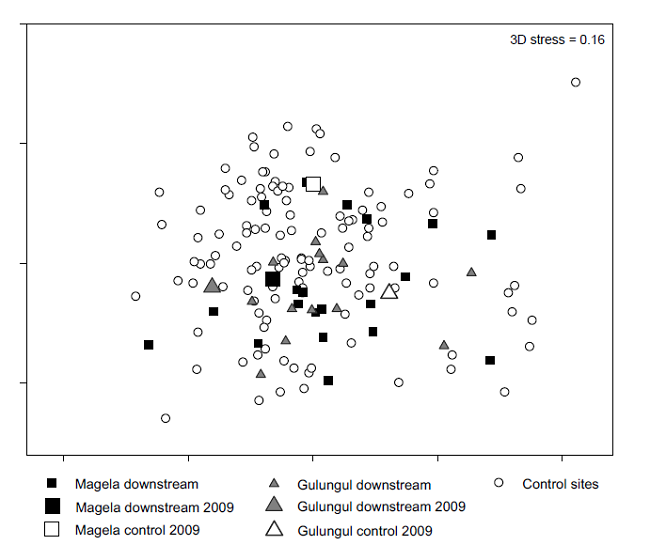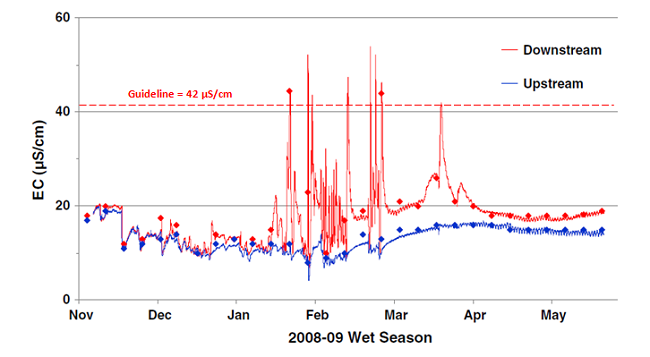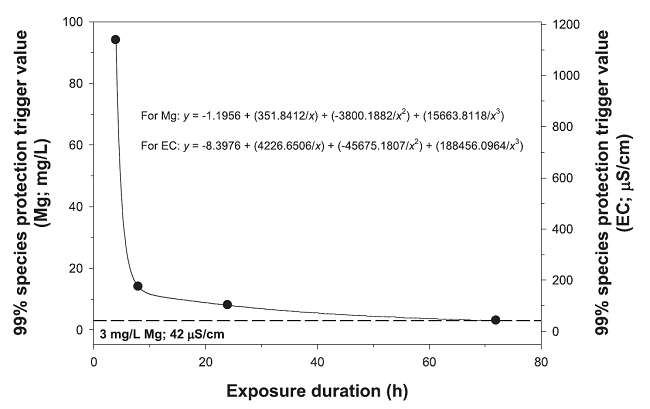Assessing discharges from a uranium mine — case study
Water used in mining can adversely affect the quality of the surface water and groundwater surrounding the mine. Assessing water discharges from mines is important to ensure compliance with licence conditions and, ultimately, to ensure environmental protection.
About the site
Ranger mine is located on the 79 km2 Ranger Project Area 260 km east of Darwin, Northern Territory. The site is surrounded by, but separate from, the World Heritage listed Kakadu National Park.
The Ranger Project Area is part of the Alligator Rivers Region, which includes the catchments of the West, South and East Alligator rivers. It contains high conservation, high ecological value aquatic ecosystems in its surrounding waterways.
Discovered in 1969 and first opened in 1980, the Ranger mine is owned by Energy Resources of Australia Limited, a subsidiary of Rio Tinto. Uranium mined at Ranger provides nuclear power in Asia, Europe and North America. Mine operations have reduced to processing of stockpiled uranium oxide ore since open-cut mining ceased in 2012.
Applying the Water Quality Management Framework
After more than 30 years in operation, the Ranger mine operator and regulators have undertaken many water quality assessments. These assessments represent multiple cycles through the Water Quality Management Framework.
This case study focuses on a more recent issue to assess mine waters with high levels of magnesium sulfate (MgSO4) and their discharge into an adjacent waterway, Magela Creek.
Examine current understanding
What did we discover about the issue?
Scientific and regulatory work completed in the 1970s and 1980s identified that the key environmental risks at Ranger were associated with discharges of mine waters to the surrounding World Heritage and Ramsar-listed waterways. Key stressors included uranium, magnesium, radium, manganese and turbidity.
In the mid 1990s, the Environmental Research Institute of the Supervising Scientist (ERISS) studied the aquatic ecology of water bodies (e.g. billabongs) around the mine.
The research produced empirical data on the significance of electrical conductivity (EC) — an indicator of salinity — as a stressor for aquatic systems in these water bodies (O’Connor et al. 1995, O’Connor et al. 1996). Data showed a strong correlation between effects on billabong macroinvertebrate communities and EC.
In mine waters, EC is known to be dominated by MgSO4 (Figure 1). As such, the research flagged MgSO4 as the key stressor of aquatic ecosystems when it had not previously been considered a significant concern.
Figure 1 Strong relationship between magnesium (Mg) and electrical conductivity (EC) in creek waters upstream and downstream of Ranger mine. Source: Sinclair et al. 2014
MgSO4, also known as epsomite (MgSO4·7H2O), occurs naturally in the environment. It can be a common mine contaminant arising from runoff over and through waste rock. Some freshwater aquatic species are more sensitive to its toxic effects than others (van Dam et al. 2010).
Key concepts:See also:
Define community values and management goals
What types of community values and specific management goals did we set to protect the aquatic ecosystems in Magela Creek?
As noted earlier, Kakadu is both World Heritage and Ramsar-listed. As such, the areas surrounding the mine, including the waterways, are of very high ecological and conservation value.
Community values
The highly valued aquatic ecosystems surrounding the mine represent a key community value for the region.
The area has a 40,000+ year history of continuous habitation by Indigenous Australians so it has very strong cultural and spiritual values.
Management goals
Reflecting the ecological significance of the region, a management goal of ‘no change in biodiversity’ was agreed for the waterways off the Ranger Project Area when the mine was opened.
In trying to capture traditional owner wishes for the region to not be affected by mining at all, an additional management goal was agreed to minimise perturbations in water quality above natural background levels wherever possible.
Both these management goals reflect a very high level of protection, reflective of the excellent ecological condition of the region.
Key concepts:
See also:
Define relevant indicators
Which indicators did we select to protect the aquatic ecosystems in Magela Creek from magnesium (Mg) ions in mine water discharges?
To assess this issue, we used multiple indicators across two lines of evidence (Table 1). The use of a multiple lines of evidence approach in a weight-of-evidence process for assessing the implications of mine water discharges was very important for ensuring increased stakeholder confidence in the outcomes and recommendations.
Other indicators are monitored for Ranger (e.g. uranium, manganese, radium, bioaccumulation in mussels) but not discussed in this case study.
Table 1 Relevant indicators selected for Magela Creek to assess and monitor effects of Mg
| Causal pathway element |
Line of evidence |
|---|---|
|
Stressor |
Chemistry
|
|
Ecosystem receptor |
Toxicity
|
|
Biodiversity
|
To implement these indicators, we:
- monitored water quality for EC, Mg and sulfate (SO4)
- assessed MgSO4 toxicity to local aquatic species using laboratory toxicity studies to derive site-specific guideline values
- used in situ toxicity monitoring using a local freshwater snail, both upstream and at the compliance site, as an early warning indicator of any effects
- undertook end-of-wet-season biological monitoring of aquatic (fish and macroinvertebrate) communities to detect any long-term community-level effects.
Key concepts:
See also:
Determine water quality guideline values
How did we determine water quality guideline values for each of the indicators we selected for Magela Creek?
Laboratory toxicity studies (over 3 to 6 days depending on the species) confirmed that Mg was the ion toxic to aquatic species, not SO4 (van Dam et al. 2010).
We also found that Mg toxicity is dependent on calcium (Ca) concentration. Keeping the ratio of Mg to Ca below 9:1 reduced the risk of toxic effects to aquatic species.
Using this knowledge, we set a site-specific guideline value of 3 mg/L for Mg (or 42 μS/cm) to protect 99% of aquatic species in the waterway.
The guideline value we set for each the biological indicators — snail toxicity monitoring and macroinvertebrate and fish communities — was that exposed sites were not significantly different from unexposed sites.
Key concepts:
See also:
Define draft water quality objectives
Based on our guideline value, what water quality objectives did we set to ensure the protection of our community values and management goals for Magela Creek?
The guideline value have been formalised as water quality objectives. However, in line with cultural values and the wishes of the traditional owners, we supplemented each guideline value derived at Step 4 with narrative statements that reflected the management goal of minimising perturbations downstream of the mine where practical.
Water quality objectives for magnesium in Magela Creek
- To ensure that the Mg:Ca (mass) ratio does not exceed 9:1.
- To report and act on any trigger exceedances at the compliance site, where the guideline values are set out in a 3-tiered management framework:
- focus = 1 mg/L (or 20 μS/cm)
- action = 2 mg/L (or 30 μS/cm)
- limit = 3 mg/L (or 42 μS/cm).
- To sustain the lower Mg concentrations measured in the 2003–04 to 2007–08 wet seasons where practical.
Measures of success
- 100% of downstream Mg concentrations are below the limit and there are no sustained increases above the focus and action triggers. All exceedances are reported and investigated according to a procedure originally developed by Iles (2004).
- Mg concentrations and Mg:Ca ratios will not be significantly higher than those of the 2003–04 to 2007–08 wet seasons without reasonable cause.
Key concept:
See also:
Assess draft water objectives
Did the monitoring data support the draft water quality objectives?
Depending on the outcome of this assessment, we have different options:
- yes — continue management and monitoring to ensure protection of aquatic species in the waterway.
- no — move to Steps 7 and 8, which can be completed in parallel, in consultation with the regulator.
Our monitoring data for various indicators across multiple lines of evidence included:
- EC (with corresponding water quality limit)
- in situ monitoring for the freshwater snail
- end-of-wet-season monitoring of stream macroinvertebrate communities.
In the 2007–08 wet season, water quality (measured as EC) was good, with no exceedances of the Mg/EC water quality limit (Figure 2). This was supported by in situ monitoring of the freshwater snail, which showed that downstream egg production was consistent with our upstream baseline (Figure 3). Under this outcome, the approach is to continue management and monitoring (i.e. through moving to Step 10) and keep learning and improving the understanding.
However, the EC monitoring data in the 2008–09 wet season did not support our draft water quality objectives (Figure 2). There were some exceedances of the Mg/EC limit, indicating poorer water quality due to mine water discharges. But in situ toxicity monitoring of the freshwater snail showed no adverse response to this water quality perturbation.
Figure 2 Electrical conductivity (EC) monitoring data for the Magela Creek compliance site used to assess draft water quality objectives, 2007–10. Source: Supervising Scientist 2016
Figure 3 In situ snail egg monitoring data for the Magela Creek compliance (exposed) and baseline (control) sites used to assess water quality objectives, 2006–10. Source: Supervising Scientist 2009
Using multiple lines of evidence enhances our ability to infer cause and effect and, ultimately, we also look at end-of-wet-season community-level responses. End-of-wet-season biological monitoring of aquatic communities has, to date, shown no observable effects (Figure 4). Nevertheless, the 2008–09 water quality result was a flag to investigate further at Step 7.
Figure 4 End-of-wet-season biological monitoring of stream macroinvertebrate communities in Magela Creek, 2009. Source: Supervising Scientist 2009
Key concepts:
See also:
Consider other indicators or refine water quality objectives
Was the water quality objective appropriate for Magela Creek, or could it have been improved?
When we commenced continuous EC monitoring in the mid 2000s (compared to weekly grab sampling), we began to see many more exceedances but only for very short durations of minutes to hours (Figure 5).
Figure 5 Continuous monitoring of electrical conductivity (EC) at the Magela Creek compliance site detected more frequent exceedances of very short durations. Source: Sinclair et al. 2014
Our water quality objectives determined at Step 4 were based on toxicity exposures over 3 to 6 days, which suggested we needed to refine our guideline values to better reflect the actual exposure regime.
To assess the exceedances according to their duration, we undertook further laboratory toxicity studies to refine our guideline value to account for exposure duration (Figure 6; Hogan et al. 2013), and created a handy guideline value conversion table (Table 2) for our event-based guideline values.
Figure 6 Guideline values for magnesium (Mg) and electrical conductivity (EC) over time for exposure of aquatic species to toxic ions after a mine water discharge into Magela Creek. Source: Hogan et al. 2013
Table 2 Conversion table for electrical conductivity (EC) and magnesium (Mg) guideline values after a mine water discharge into Magela Creek
| Pulse duration (hours) | EC guideline value (μS/cm) | Mg guideline value (mg/L) |
|---|---|---|
| 1 | 1140 | 977.0 |
| 2 | 1140 | 437.0 |
| 3 | 1140 | 199.0 |
| 4 | 1140 | 94.0 |
| 6 | 334 | 27.0 |
| 8 | 174 | 14.0 |
| 10 | 139 | 11.0 |
| 12 | 129 | 10.0 |
| 14 | 123 | 10.0 |
| 16 | 118 | 9.4 |
| 18 | 114 | 9.0 |
| 20 | 110 | 8.6 |
| 22 | 106 | 8.3 |
| 24 | 102 | 8.0 |
| 30 | 91 | 7.1 |
| 36 | 82 | 6.3 |
| 48 | 65 | 5.0 |
| 60 | 52 | 3.9 |
| 72 | 42 | 3.0 |
Key concept:
See also:
Consider alternative management strategies
What could have been done differently, from a management perspective, to increase the chance of achieving the water quality objectives and management goals?
In parallel to our work at Step 7, the mine operator was reviewing other ways to improve mine water quality.
The mine operator implemented reverse osmosis (RO) and brine concentration treatment technologies to remove salts and metals from mine discharge water.
The treatments effectively removed the toxic Mg ion from the water (Table 3).
Interestingly, the treatments introduced other issues, including the risk of elemental or nutrient deficiency, which required an updating of the current understanding (Step 1) and was addressed through a subsequent cycle of the Water Quality Management Framework.
Table 3 Effectiveness of reverse osmosis (RO) and brine concentration water treatment on the electrical conductivity (EC) of Ranger mine water discharges where the water quality objective was to not exceed 42 μS/cm in Magela Creek for more than 72 hours
| Type of water | Pre-treatment EC (μS/cm) | Post-treatment EC (μS/cm), prior to discharge |
|---|---|---|
| Pond | 1,200 | 20 |
| Process | 25,000 | < 5 |
Key concepts:
See also:
Assess whether water quality objectives are achievable and Step 10 — implement agreed management strategy
Did the management strategy help us to achieve the water quality objective?
Depending on the outcome of this assessment, we have different options:
- yes — continue to Step 10 and implement the agreed management strategy.
- no — return to Step 2 to consider the appropriateness of the management goals or implement actions as required under the waste discharge licence.
We found that by refining the guideline values to more appropriate event-based guideline values, the water quality objectives were met, and the appropriate high level of protection was still provided. As a result, the event-based framework was implemented into the licence conditions in late 2013 (Figure 7).
Figure 7 Excerpt from revised water quality objectives for Magela Creek compliance site, Ranger mine
The knowledge gained throughout this process has greatly increased our ability to interpret and understand consequences of mine water discharges.
Also, the water treatment strategies at Ranger mine have further reduced the risk of the EC and Mg concentrations exceeding the water quality objectives, although we had to address new issues introduced by the treatment process, by feeding back through the Water Quality Management Framework.
Key concepts:
See also:
References
Hogan AC, Trenfield MA, Harford AJ & van Dam RA 2013, Toxicity of magnesium pulses to tropical freshwater species and the development of a duration-based water quality guideline, Environmental Toxicology and Chemistry 32: 1969–1980.
Iles M 2004, ‘Water quality objectives for Magela Creek — revised November 2004’, internal report no. 489, Supervising Scientist, Darwin.
O’Connor R, Humphrey C, Dostine P, Lynch C & Spiers A 1995, ‘A survey of aquatic macroinvertebrates in lentic waterbodies of Magela and Nourlangie Creek catchments, Alligator Rivers Region, Northern Territory’, internal report no. 225, Supervising Scientist, Darwin.
O’Connor R, Humphrey C, Lynch C & Klessa B 1996, ‘A survey of macroinvertebrates in lentic waterbodies of Magela and Nourlangie Creek catchments, Alligator Rivers Region, NT: second year of data’, internal report no. 242, Supervising Scientist, Darwin.
Sinclair A, Tayler K, van Dam R & Hogan A 2014, Site-specific water quality guidelines: 2. Development of a water quality regulation framework for pulse exposures of mine water discharges at a uranium mine in northern Australia, Environmental Science and Pollution Research 21: 131–140.
Supervising Scientist 2009, ‘Annual Report 2008–2009’, Supervising Scientist, Darwin.
Supervising Scientist 2016, Ranger Mine Monitoring Data, Department of the Environment and energy website, Supervising Scientist, Darwin, accessed 23 June 2016.
van Dam RA, Hogan AC, McCullough CD, Houston MA, Humphrey CL & Harford AJ, 2010, Aquatic toxicity of magnesium sulfate, and the influence of calcium, in very low ionic concentration water, Environmental Toxicology Chemistry 29(2): 410–421.

